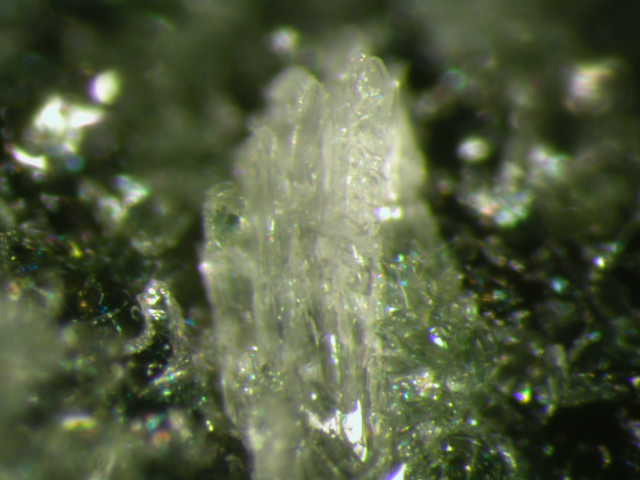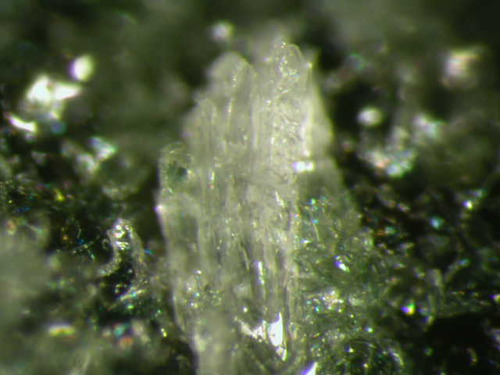Jimthompsonite
A valid IMA mineral species
This page is currently not sponsored. Click here to sponsor this page.
About Jimthompsonite
Formula:
(Mg,Fe)5Si6O16(OH)2
Colour:
Colorless to very light pinkish brown
Lustre:
Vitreous, Sub-Vitreous
Hardness:
6 - 7
Specific Gravity:
3.05 (Calculated)
Crystal System:
Orthorhombic
Name:
Named by David R. Veblen and Charles W. Burnham in 1978 in honor of James (Jim) B. Thompson, jr., [November 20, 1921 Calais, Maine, USA - November 15, 2011, Calais, Maine, USA], mineralogist and petrologist, late professor/emeritus at Harvard University, USA.
Jimthompsonite occurs as ultra-microscopic intergrowths within other host minerals, generally amphiboles such as anthophyllite or cummingtonite-series minerals. Jimthompsonite is generally not visible to the naked eye, but instead is observable optically or by transmission electron microscopy.
Unique Identifiers
Mindat ID:
2096
Long-form identifier:
mindat:1:1:2096:7
GUID
(UUID V4):
(UUID V4):
b49e5497-cb81-480e-bd7c-0d725e1b09e5
IMA Classification of Jimthompsonite
Classification of Jimthompsonite
9.DF.05
9 : SILICATES (Germanates)
D : Inosilicates
F : Inosilicates with 2-periodic multiple chains
9 : SILICATES (Germanates)
D : Inosilicates
F : Inosilicates with 2-periodic multiple chains
67.1.1.1
67 : INOSILICATES Unbranched Chains with W > 2
1 : Unbranched Chains with W>2 with W=3
67 : INOSILICATES Unbranched Chains with W > 2
1 : Unbranched Chains with W>2 with W=3
14.21.11
14 : Silicates not Containing Aluminum
21 : Silicates of Fe and Mg
14 : Silicates not Containing Aluminum
21 : Silicates of Fe and Mg
Mineral Symbols
As of 2021 there are now IMA–CNMNC approved mineral symbols (abbreviations) for each mineral species, useful for tables and diagrams.
Please only use the official IMA–CNMNC symbol. Older variants are listed for historical use only.
Please only use the official IMA–CNMNC symbol. Older variants are listed for historical use only.
| Symbol | Source | Reference |
|---|---|---|
| Jim | IMA–CNMNC | Warr, L.N. (2021). IMA–CNMNC approved mineral symbols. Mineralogical Magazine, 85(3), 291-320. doi:10.1180/mgm.2021.43 |
| Jim | Whitney & Evans (2010) | Whitney, D.L. and Evans, B.W. (2010) Abbreviations for names of rock-forming minerals. American Mineralogist, 95, 185–187 doi:10.2138/am.2010.3371 |
Physical Properties of Jimthompsonite
Vitreous, Sub-Vitreous
Transparency:
Transparent
Colour:
Colorless to very light pinkish brown
Streak:
Colorless
Hardness:
6 - 7 on Mohs scale
Hardness Data:
Estimated
Comment:
Undetermined; presumably similar to amphibole.
Tenacity:
Brittle
Cleavage:
Perfect
Perfect on {210}, intersecting at 38° and 142°.
Perfect on {210}, intersecting at 38° and 142°.
Parting:
Breakage on {100} and {010} may be partings.
Fracture:
Splintery
Density:
3.05 g/cm3 (Calculated)
Optical Data of Jimthompsonite
Type:
Biaxial (-)
RI values:
nα = 1.605 nβ = 1.626 nγ = 1.633
2V:
Measured: 62° , Calculated: 58°
Birefringence:
0.028
Max Birefringence:
δ = 0.028

Image shows birefringence interference colour range (at 30µm thickness)
and does not take into account mineral colouration.
and does not take into account mineral colouration.
Surface Relief:
Moderate
Dispersion:
r > v weak
Optical Extinction:
Parallel. XYZ = abc.
Pleochroism:
Non-pleochroic
Chemistry of Jimthompsonite
Mindat Formula:
(Mg,Fe)5Si6O16(OH)2
Common Impurities:
Al,Mn,Ca,Na,H2O
Crystallography of Jimthompsonite
Crystal System:
Orthorhombic
Class (H-M):
mmm (2/m 2/m 2/m) - Dipyramidal
Space Group:
Pbca
Setting:
Pbca
Cell Parameters:
a = 18.626 Å, b = 27.23 Å, c = 5.297 Å
Ratio:
a:b:c = 0.684 : 1 : 0.195
Unit Cell V:
2,686.56 ų (Calculated from Unit Cell)
Z:
8
Morphology:
Fibrous intergrowths in host crystals to 5 cm.
Crystal Structure
Load
Unit Cell | Unit Cell Packed
2x2x2 | 3x3x3 | 4x4x4
Unit Cell | Unit Cell Packed
2x2x2 | 3x3x3 | 4x4x4
Show
Big Balls | Small Balls | Just Balls | Spacefill
Polyhedra Off | Si Polyhedra | All Polyhedra
Remove metal-metal sticks
Big Balls | Small Balls | Just Balls | Spacefill
Polyhedra Off | Si Polyhedra | All Polyhedra
Remove metal-metal sticks
Display Options
Black Background | White Background
Perspective On | Perspective Off
2D | Stereo | Red-Blue | Red-Cyan
Black Background | White Background
Perspective On | Perspective Off
2D | Stereo | Red-Blue | Red-Cyan
View
CIF File Best | x | y | z | a | b | c
CIF File Best | x | y | z | a | b | c
Rotation
Stop | Start
Stop | Start
Labels
Console Off | On | Grey | Yellow
Console Off | On | Grey | Yellow
Data courtesy of the American Mineralogist Crystal Structure Database. Click on an AMCSD ID to view structure
| ID | Species | Reference | Link | Year | Locality | Pressure (GPa) | Temp (K) |
|---|---|---|---|---|---|---|---|
| 0000687 | Jimthompsonite | Veblen D R, Burnham C W (1978) New biopyriboles from Chester, Vermont: II. The crystal chemistry of jimthompsonite, clinojimthompsonite, and chesterite, and the amphibole-mica reaction American Mineralogist 63 1053-1073 |  | 1978 | 0 | 293 |
CIF Raw Data - click here to close
X-Ray Powder Diffraction
Powder Diffraction Data:
| d-spacing | Intensity |
|---|---|
| 13.6 Å | (60) |
| 8.81 Å | (100) |
| 3.81 Å | (30) |
| 3.25 Å | (40) |
| 3.09 Å | (50) |
| 2.74 Å | (30) |
| 2.60 Å | (40) |
| 2.55 Å | (30) |
Comments:
ICDD 31-638 (calculated)
Geological Environment
Paragenetic Mode(s):
| Paragenetic Mode | Earliest Age (Ga) |
|---|---|
| Stage 2: Planetesimal differentiation and alteration | 4.566-4.550 |
| 6 : Secondary asteroid phases | 4.566-4.560 |
| Stage 5: Initiation of plate tectonics | <3.5-2.5 |
| 40 : Regional metamorphism (greenschist, amphibolite, granulite facies) |
Type Occurrence of Jimthompsonite
General Appearance of Type Material:
Occurs as fibrous crystals or microscopic intergrowths parallel to (010) in anthophyllite and cummingtonite.
Place of Conservation of Type Material:
Royal Ontario Museum, Toronto, Canada, M36083.
Harvard University, Cambridge, Massachusetts, USA.
National Museum of Natural History, Washington, D.C., USA, 145689.
Harvard University, Cambridge, Massachusetts, USA.
National Museum of Natural History, Washington, D.C., USA, 145689.
Geological Setting of Type Material:
Found in the blackwall zone of a metamorphosed ultramafic body.
Associated Minerals at Type Locality:
Synonyms of Jimthompsonite
Other Language Names for Jimthompsonite
Common Associates
Associated Minerals Based on Photo Data:
| 13 photos of Jimthompsonite associated with Clinojimthompsonite | (Mg,Fe)5Si6O16(OH)2 |
| 12 photos of Jimthompsonite associated with Chesterite | (Mg,Fe)17Si20O54(OH)6 |
| 11 photos of Jimthompsonite associated with Anthophyllite | ◻{Mg2}{Mg5}(Si8O22)(OH)2 |
| 10 photos of Jimthompsonite associated with Talc | Mg3Si4O10(OH)2 |
| 10 photos of Jimthompsonite associated with Magnetite | Fe2+Fe3+2O4 |
| 3 photos of Jimthompsonite associated with Pyrite | FeS2 |
Related Minerals - Strunz-mindat Grouping
| 9.DF. | Bohseite | Ca4Be3+xAl1-xSi9O25-x(OH)3+x |
| 9.DF.05 | Chesterite | (Mg,Fe)17Si20O54(OH)6 |
| 9.DF.05 | Clinojimthompsonite | (Mg,Fe)5Si6O16(OH)2 |
| 9.DF.15 | Ershovite | Na4K3(Fe,Mn,Ti)2Si8O22(OH)4 · 4H2O |
| 9.DF.15 | Paraershovite | Na3K3Fe3+2Si8O20(OH)4 · 4H2O |
| 9.DF.20 | Tvedalite | (Ca,Mn)4Be3Si6O17(OH)4 · 3H2O |
| 9.DF.25 | Bavenite | Ca4Be2Al2Si9O26(OH)2 |
| 9.DF.30 | Bigcreekite | BaSi2O5 · 4H2O |
Fluorescence of Jimthompsonite
Not fluorescent
Other Information
Health Risks:
No information on health risks for this material has been entered into the database. You should always treat mineral specimens with care.
Internet Links for Jimthompsonite
mindat.org URL:
https://www.mindat.org/min-2096.html
Please feel free to link to this page.
Please feel free to link to this page.
Search Engines:
External Links:
Mineral Dealers:
References for Jimthompsonite
Reference List:
Localities for Jimthompsonite
Locality List
 - This locality has map coordinates listed.
- This locality has map coordinates listed.
 - This locality has estimated coordinates.
ⓘ - Click for references and further information on this occurrence.
? - Indicates mineral may be doubtful at this locality.
- This locality has estimated coordinates.
ⓘ - Click for references and further information on this occurrence.
? - Indicates mineral may be doubtful at this locality.
 - Good crystals or important locality for species.
- Good crystals or important locality for species.
 - World class for species or very significant.
(TL) - Type Locality for a valid mineral species.
(FRL) - First Recorded Locality for everything else (eg varieties).
- World class for species or very significant.
(TL) - Type Locality for a valid mineral species.
(FRL) - First Recorded Locality for everything else (eg varieties).
All localities listed without proper references should be considered as questionable.
Finland | |
| |
Greenland | |
| |
Italy | |
| |
Japan | |
| |
Norway | |
| |
Switzerland | |
| |
| |
UK | |
| |
USA (TL) | |
|
Quick NavTopAbout JimthompsoniteUnique IdentifiersIMA Classification Classification Mineral SymbolsPhysical Properties Optical Data Chemistry Crystallography Crystal StructureX-Ray Powder DiffractionGeological EnvironmentType Occurrence SynonymsOther LanguagesCommon AssociatesStrunz-MindatFluorescence Other InformationInternet Links References Localities Locality List







 symbol to view information about a locality.
The
symbol to view information about a locality.
The 



Carlton Quarry, Chester, Windsor County, Vermont, USA